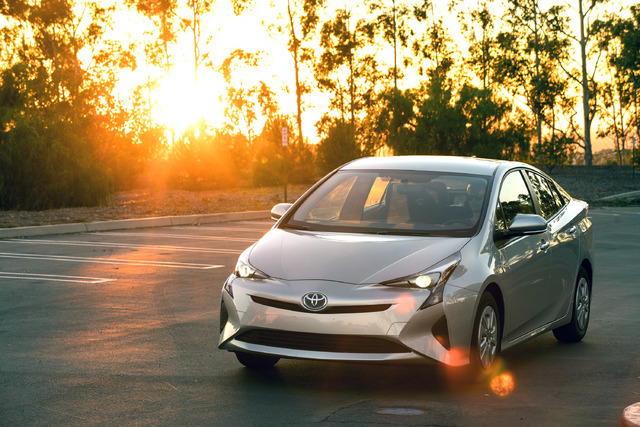Four generations on, Toyota Prius keeps raising the stakes

An all-new Prius doesn’t come along every day. In fact, there have only been three distinct models since the Prius was introduced in North America for 2000. That makes the new-for-2016 Prius a pretty big deal for fans of the brand.
With total sales of more than 3.5 million cars globally over nearly 20 years, the Prius remains the undisputed king of hybrids. The latest hatchback is redesigned with new — and generally attractive — sheet metal. The Prius has pretty much shed its wallflower looks for knife-edge creases at both ends and along the sides. At least you’ll never confuse it for any other model in Toyota’s fleet, which is exactly the point.
The body is grafted to a considerably stiffened platform that, along with a more modern rear suspension, aids driving dynamics and helps cut road noise.
The new Prius is about 2.4 inches longer, 0.6 of an inch wider and 0.8 of an inch lower than the previous version, while the distance between the front and rear wheels remains unchanged. In the flesh, however, the car seems quite a bit larger.
It’s only when you step inside that the design goes awry. In particular, the dashboard is a mash-up of disconnected shapes amidst vast swaths of vacant blandness (the optional two-tone interior mitigates the monotony somewhat). You would have thought by now that the center-mounted display panel would have been abandoned for easier-to-view and more esthetically pleasing gauges and info screens located ahead of the driver.
In any event, this shouldn’t bother the Prius faithful who are probably more concerned more about the hybrid’s fuel efficiency than any styling/functionality issues.
On the plus side, the seats have been significantly improved and the cargo area behind the split-folding rear bench has been increased a notch.
The powertrain also delivers increases of its own but not where you might expect it. On its own, the 1.8-liter gasoline engine produces 95 horsepower and 105 pound-feet of torque. It operates in tandem with an electric motor that produces 71 horsepower. Combined, the power team makes 121 horsepower, which is down slightly from before.
As before, a continuously variable transmission (CVT) directs power to the front wheels.
For the base Prius, an older-style nickel-metal hydride battery pack situated under the rear seat supplies power to the electric motor, while lighter and more compact lithium-ion batteries are the energy source in all other trims.
Regardless of system, fuel economy is rated at 54 mpg in the city and 50 mpg on the highway (up from the previous 51/48 rating). Those numbers improve to 58/53 for the slightly lighter Eco model that’s fitted with special low-rolling-resistance tires.
At $25,500 starting price, including destination fees, the base Prius Two receives the usual accoutrements, although the lighter Prius Two Eco loses the rear-window wiper and temporary spare tire.
The Prius Three (at least the Prius’ model nomenclature is easy to remember, even if it doesn’t begin at One) adds touch-screen navigation, premium audio system, fancier interior trim and wireless phone charging.
At the top end, the Prius Four has power-adjustable heated front seats, rain-sensing wipers and a tonneau cover, while the Prius Four Touring includes a firmer suspension, unique grille treatment plus 17-inch wheels (15-inchers are standard).
The Four is required to add a power moonroof and the latest active safety equipment, such as emergency braking, which is a feature that Toyota says it will make standard “on nearly every model and trim level by the end of 2017.”
Also for 2017, the Prius will be joined by a new plug-in model called Prius Prime as well as a wagon derivative to replace the current Prius v.
Gregg Smith, an Internet salesman at David Wilson’s Toyota of Las Vegas, said the Prius’ redesign equals better gas mileage and a more comfortable and roomier vehicle.
“It features generation-4 technology on the engine and transmission and also has a redesigned body so the lines are different,” he said. “Its looks and interior are a lot different.”
He added that the Prius is a great option for those looking to save money on gas.
“It hits the gamut from people looking for a comfortable car to drive, all the way to those looking to get maximum mileage,” he said. “You’ll save some money on gas and because it runs on both electric and gas engines it has higher combined horsepower and a lot of pep.”
There really isn’t a serious competitor on the market that’s similarly priced and equipped like the 2016 Prius, so there’s nothing really standing in the way of putting one in your driveway, other than the payments. The one fly in the ointment is low fuel prices, which means that there’s little fuel savings to offset the extra cost of gas-electric hybrid transportation. But one thing we should have learned by now is that fuel prices won’t stay low forever.